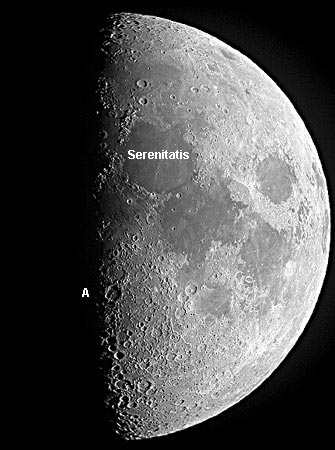Difference between revisions of "January 1, 2015"
| (2 intermediate revisions by one other user not shown) | |||
| Line 48: | Line 48: | ||
<!-- Cleanup of credits --> | <!-- Cleanup of credits --> | ||
<p> </p> | <p> </p> | ||
| − | + | {{wiki/ArticleFooter}} | |
| − | |||
| − | |||
| − | |||
| − | |||
| − | |||
| − | |||
| − | |||
| − | |||
| − | |||
| − | |||
| − | |||
Latest revision as of 10:05, 15 March 2015
First Quarter Moon
Originally published January 1, 2004
|
First Quarter Moon A great time to begin observing the Moon is near first quarter, when the terminator - the sunrise line - slices right thru the middle of the Moon. This Moon image, taken with a 14" SCT and a Nikon Coolpix digital camera, shows the dark circular maria - vast piles of lava - on the eastern (right) hemisphere of the Moon. Along the terminator, craters and mountains cast dramatic shadows, making features fascinating to observe. This image has about the same lighting conditions as Galileo's drawing - upper left masthead - from 1609. On both the drawing and the modern image you can see Mare Serenitatis just east of the terminator, and two mountain ranges crossing it. Galileo's very prominent crater further south on the terminator is clearly exaggerated in size, but can't be identified with certainty; could it be Albategnius (labeled A)? Related Links:
Yesterday's LPOD: 2010 And the Future Tomorrow's LPOD: Cauchy Faults, Rilles and Domes |
Author & Editor:
Charles A. Wood
COMMENTS?
Register, Log in, and join in the comments.




